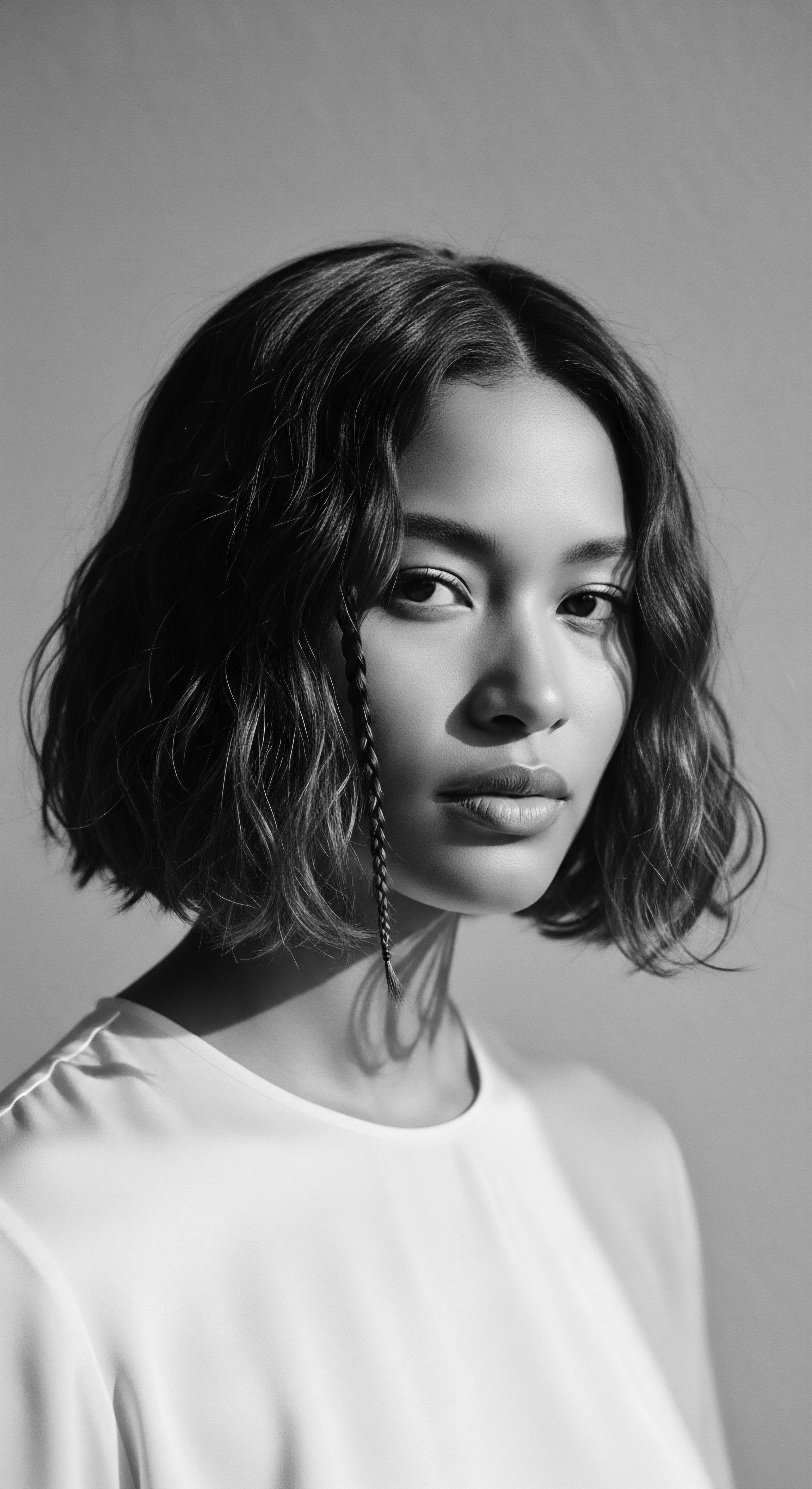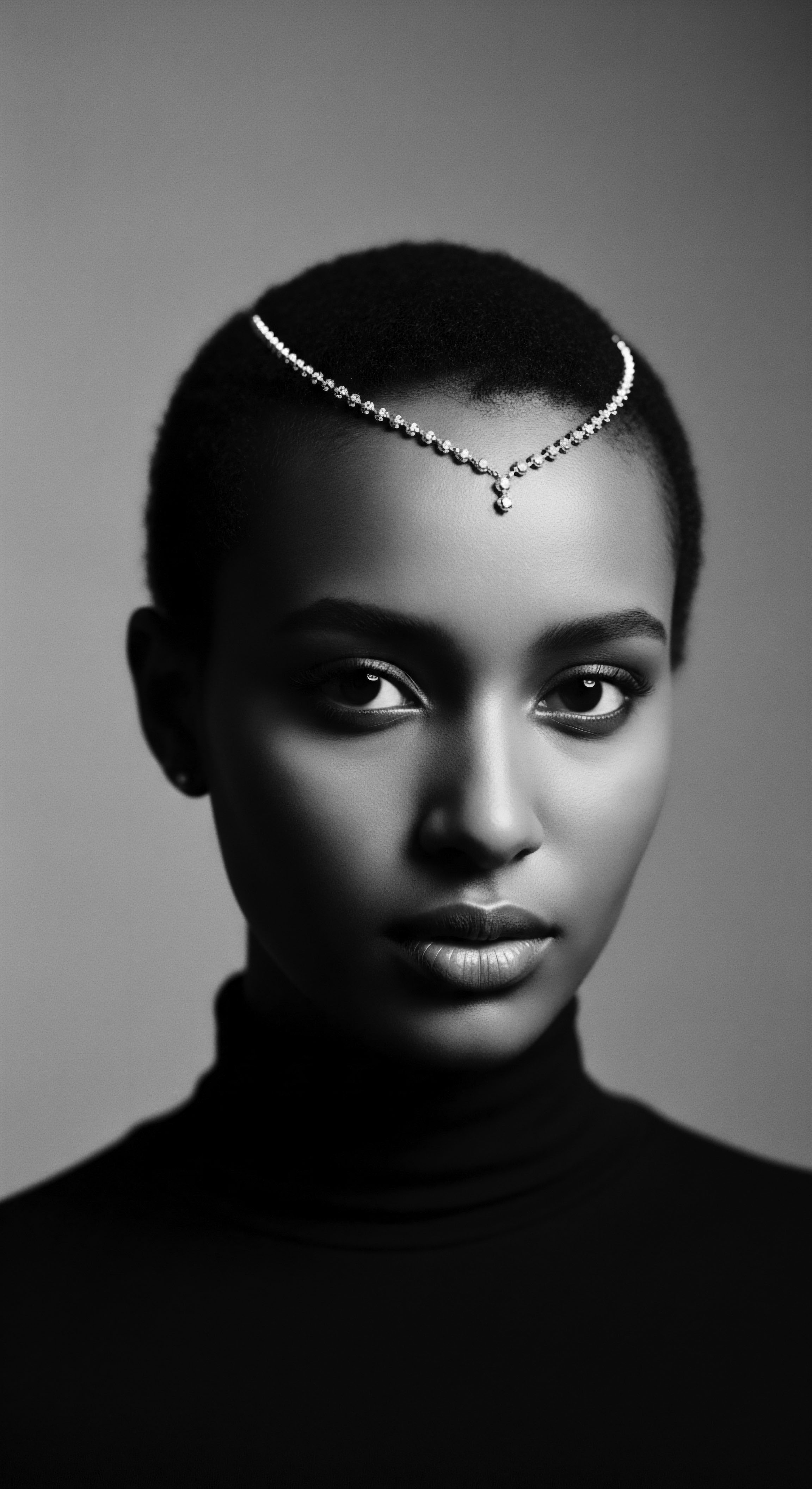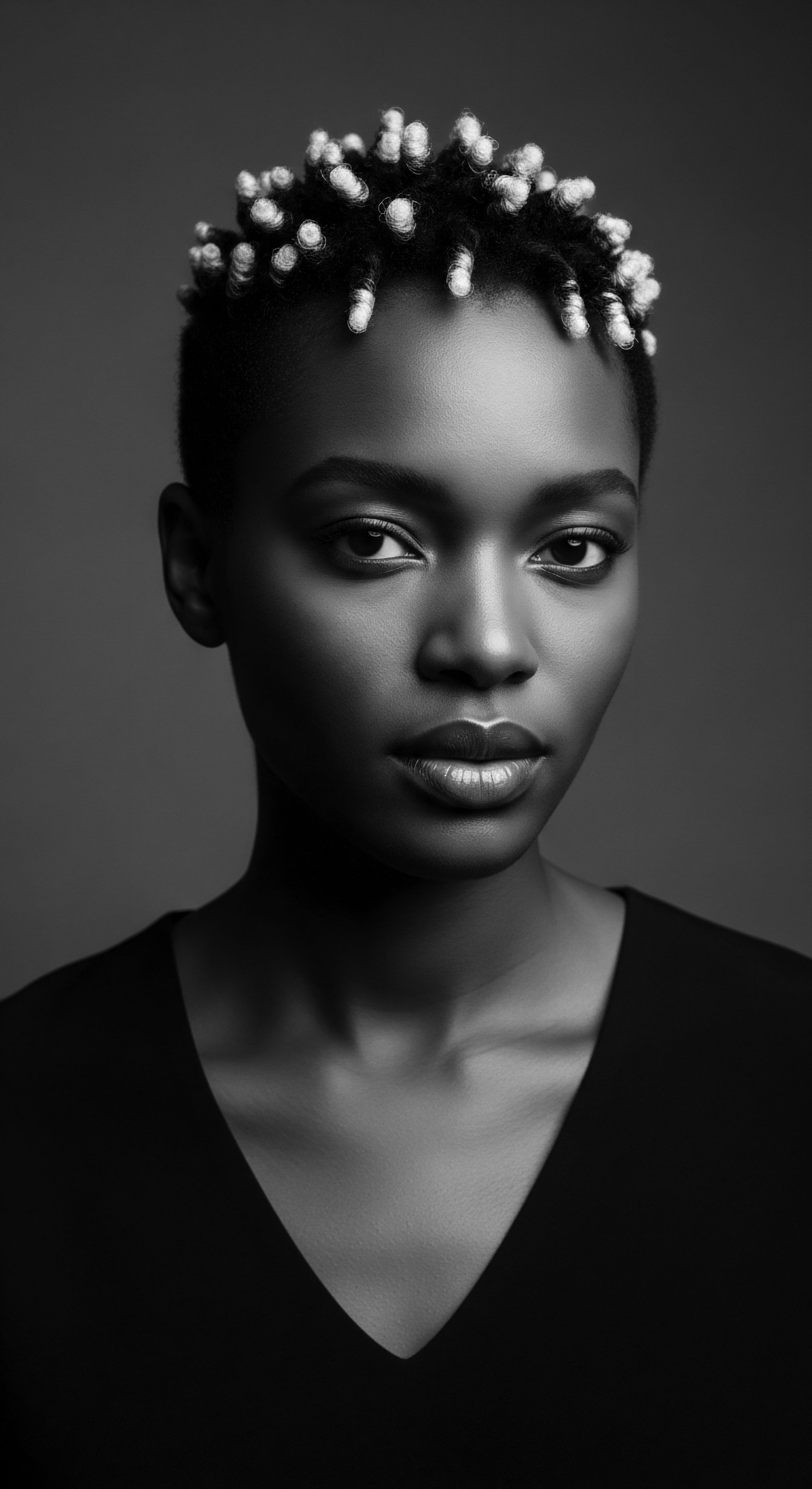
Fundamentals
The distant echoes of humanity’s earliest adornment practices reveal a deep understanding of self, community, and the natural world, even as far back as the Neolithic era. When we speak of Neolithic Hair Practices, we refer to the collective grooming rituals, styling choices, and cultural expressions involving hair that marked the New Stone Age, a period spanning roughly from 10,000 BCE to 3,000 BCE. This span of human history saw transformative shifts, from nomadic hunter-gatherer existences to settled agrarian societies, and with this stability arrived more refined approaches to personal and communal presentation.
Hair, in its fundamental biology and its outward presentation, held a significant place within these burgeoning societies, moving beyond mere biological function to become a canvas for identity and belonging. The elucidation of these practices offers a window into the foundational wisdom from which many of our modern hair care traditions, especially those honoring textured hair, ultimately derive.
The essential meaning of Neolithic Hair Practices rests upon the profound connection between the human form and the emerging social structures of the time. These practices were not born of vanity in the contemporary sense. Rather, they represented a practical engagement with the environment and a conscious step towards ordered communal life. Early human beings, faced with the elements, quickly learned the protective and symbolic qualities of hair.
The initial shaping of hair, whether through crude cutting or basic manipulation, likely served vital purposes ❉ keeping hair out of the eyes during strenuous tasks, preventing tangles that could harbor parasites, or perhaps signifying maturity or readiness for a specific role within the group. The descriptive power of these early hair expressions tells a silent story of survival and burgeoning societal organization.

Echoes from the Ancient Earth ❉ Primal Expressions
In the quiet dawn of human settlement, hair was a direct extension of the earthly realm. The earliest forms of human intervention with hair were elemental, mirroring the tools and materials available. Sharpened flint blades, shells, or even meticulously selected stones served as rudimentary implements for trimming or shaping hair. While direct archaeological evidence of hair itself from this distant past is rare, due to its delicate, perishable nature, what remains are indirect indicators.
Figurines, cave paintings, and the imprints found within early settlements speak volumes. The meaning of these ancient hair choices resides in their immediate purpose, reflecting daily life and the practicalities of a world still intimately linked to the wilderness.
Neolithic Hair Practices represent a primal conversation between humanity and its environment, where hair served as a direct expression of life’s daily rhythms.
- Early Tools ❉ Primitive cutting edges fashioned from natural stone or shell allowed for basic hair maintenance, suggesting a purposeful engagement with the physical form.
- Organic Cleansers ❉ Early societies utilized saponin-rich plants and clays for cleansing, harnessing the natural world’s inherent purifying properties to maintain scalp and hair hygiene.
- Adornment Materials ❉ Bone, shell, and natural fibers became early adornments, transforming hair into a visible record of individual creativity and communal values.

Emergent Community and Hair’s Utility
As communities became more settled, so did the patterns of hair expression. The functional aspects of Neolithic hair practices continued to hold sway. Long hair, if left untamed, could pose challenges. It follows that securing hair, perhaps with simple binding materials such as plant fibers or animal sinews, would become common.
This might manifest as early forms of tying back the hair or even rudimentary braiding for those with the appropriate hair texture. Such actions were not merely about appearance. They were about efficiency, safety, and hygiene within communal living. The delineation of these practices reveals a society moving towards collective norms, where personal grooming started to serve a wider, shared purpose.
The initial statements of identity through hair were likely straightforward, perhaps distinguishing age groups, roles in hunting or gathering, or participation in rituals. The practices were a shared language, understood implicitly by all within the community. The overall description of Neolithic Hair Practices at this foundational level is one of practical innovation, where human ingenuity applied itself to the most accessible aspect of the body ❉ the hair. This period laid down the groundwork for the more complex and deeply symbolic hair traditions that would blossom in later eras, serving as a powerful reminder that our ancestral hair stories began with fundamental connections to the earth and our earliest social bonds.

Intermediate
Venturing deeper into the understanding of Neolithic Hair Practices uncovers a more nuanced picture, revealing them as dynamic expressions of identity, status, and community cohesion. This intermediate examination moves beyond simple utility to consider how hair became a social canvas, reflecting growing complexity within human settlements. The significance of these practices expands, encompassing a broader sense of self and collective belonging. Here, the definition of Neolithic Hair Practices broadens to include the conscious shaping of hair to convey meaning, a precursor to the intricate hair lexicons found across Black and mixed-race hair experiences today.

The Tender Thread ❉ Hair as a Social Loom
The Neolithic era, marked by advancements in agriculture and the establishment of permanent villages, saw the human population grow and interact in increasingly complex ways. With this evolution, hair ceased to be solely a matter of practical upkeep; it became a language spoken silently amongst community members. The intention behind styling shifted, bearing connotations of social standing, marital status, or tribal affiliation. For example, while not strictly Neolithic, the earliest artistic reproductions of hair styling, such as the Venus of Willendorf (estimated 28,000-25,000 BCE) and the Venus of Brassempouy (around 25,000 years old), display what appear to be meticulously styled, possibly braided or coiffed, forms of hair.
These early artistic statements, while predating the Neolithic by many millennia, point to an ancient and persistent human inclination toward detailed hair expression, a practice that certainly continued and elaborated during the New Stone Age. The interpretation of such depictions suggests that even in these early periods, hair was a medium for visual communication, delineating roles and narratives within the collective.
The emergence of more settled communities allowed for the development of refined grooming tools and techniques. Combs, perhaps crafted from bone or wood, would have been increasingly utilized not just for detangling but for precise parting and styling. The systematic application of natural oils or animal fats likely served to condition hair, add sheen, and aid in holding more elaborate styles.
These ingredients, sourced directly from their surroundings, speak to an ancestral wisdom that understood the properties of the earth’s bounty for care. The very act of hair grooming could also become a communal activity, fostering bonds and passing down intergenerational knowledge, a tradition still deeply rooted in many textured hair communities globally.
| Neolithic Element Natural Plant Cleansers |
| Archaeological Clue Residues of saponin-rich plants, historical accounts of yucca root use. |
| Enduring Parallel in Textured Hair Heritage Traditional African Black soap, Ayurvedic shikakai, and contemporary natural hair shampoos that prioritize plant-derived cleansers. |
| Neolithic Element Fats and Oils |
| Archaeological Clue Evidence of animal fats, plant oils (e.g. almond oil, sesame oil, castor oil in later antiquity). |
| Enduring Parallel in Textured Hair Heritage Shea butter, cocoa butter, coconut oil, and various natural oils deeply valued for their moisturizing and protective qualities in Black and mixed-race hair care. |
| Neolithic Element Styling Tools |
| Archaeological Clue Bone pins, sharpened stones, early combs. |
| Enduring Parallel in Textured Hair Heritage Hand-carved combs, wide-tooth combs, hairpins, and the skill of finger-styling that remain essential to managing and shaping textured hair types. |
| Neolithic Element These ancient practices lay the groundwork for modern, heritage-rooted approaches to hair care, revealing a continuous arc of wisdom. |

Hair as a Symbol ❉ Beyond Daily Ritual
The communal aspects extended into symbolic domains. Hair could represent rites of passage, such as a child’s first haircut, or signify periods of mourning or celebration. This rich network of connotations meant that changes to hair were often imbued with personal and collective gravity.
The delineation of hair styles could indicate a person’s readiness for marriage, their status as a warrior, or their connection to spiritual forces within their cultural sphere. This level of sophistication demonstrates a conscious understanding of hair as a powerful visual signifier, a conduit for non-verbal communication within tightly knit social groups.
The hair practices of the Neolithic were not just functional; they were a complex form of social communication, reflecting status, age, and communal bonds.
The conceptual framework of Neolithic Hair Practices at this intermediate stage acknowledges the transition from simple practicalities to deeply interwoven cultural narratives. The continuity of such ancestral practices, particularly the emphasis on natural ingredients, communal care, and symbolic styling, is particularly evident in the resilience and innovation seen within Black and mixed-race hair traditions. This intermediate exploration highlights that the care and presentation of hair have always been, at their core, about far more than superficial appearance; they are about belonging, identity, and the quiet perpetuation of a people’s story.

Academic
An academic definition of Neolithic Hair Practices transcends a simple chronological description, instead positioning them as a complex intersection of biological adaptation, technological innovation, social construction, and cognitive symbolism within a transformative epoch of human history. This period, roughly 10,000 to 3,000 BCE, witnessed profound societal shifts, from mobile foraging to sedentary agricultural life, a change that profoundly reshaped human interaction with the body, particularly hair. The term signifies a holistic understanding of how early human communities, adapting to new environments and social structures, developed systematic approaches to hair care, adornment, and communication. This conceptualization recognizes hair as a dynamic bio-cultural artifact, an externalized manifestation of internal societal values and individual status, grounded in empirical archaeological and ethnographic data.

Deconstructing Early Human Hair Culture ❉ A Bio-Cultural Lens
From an academic standpoint, the definition of Neolithic Hair Practices encompasses the systematic application of knowledge and available resources to manage and adorn human hair for both practical utility and sophisticated social signaling. This period saw the stabilization of communal living, which permitted the evolution of more time-intensive and intricate hair routines. The biological properties of diverse hair textures, particularly those with higher curl densities characteristic of many African populations, would have naturally favored practices like braiding and coiling for collective management and protective styling. These forms of manipulation, while aesthetically significant, also served to minimize breakage, retain moisture, and protect the scalp from environmental exposure.
The archaeological record, though often fragmented, offers compelling insights. For instance, the detection of specific micro-wear patterns on bone tools from Neolithic sites suggests their use in hair manipulation, going beyond simple cutting to imply more intricate styling or grooming activities.
The sophisticated interplay between human biology and cultural expression is especially apparent when considering the global scope of Neolithic developments. While the term “Neolithic” broadly refers to the new stone age, its manifestations varied dramatically across continents. In the context of textured hair heritage, the African continent holds an ancestral position. Evidence suggests that practices of hair manipulation, often for protective purposes and social coding, predate the formal Neolithic period in some African regions and continued with increasing sophistication.
Early rock art in the Sahara, dated to around 3500 BCE (which overlaps with the later Neolithic in other regions), displays individuals with complex cornrow patterns, providing a visual record of detailed hairstyling with communicative depth. These images confirm that elaborate hair practices were not merely a European or Near Eastern phenomenon; rather, they possessed a deep, parallel, and often preceding lineage in African societies, where hair served as a central repository of cultural identity and ancestral knowledge.
Neolithic Hair Practices embody a rich dialogue between human adaptability and the natural world, wherein hair becomes a medium for social distinction and ancestral wisdom.

Tracing the Lineage ❉ A Textured Heritage
One compelling case study that powerfully illuminates the enduring legacy of Neolithic Hair Practices, particularly its profound connection to textured hair heritage and ancestral practices, is the Himba people of Namibia . For millennia, the Himba, a semi-nomadic pastoralist community, have maintained distinctive hair traditions that directly echo the elemental and symbolic uses of natural resources characteristic of ancient eras. Their signature hairstyle, known as Otjize, involves covering their hair and skin with a mixture of red ochre powder, butterfat, and sometimes aromatic resins. This practice, far from being purely aesthetic, serves a multifaceted purpose that reflects deep ancestral wisdom.
The otjize acts as a protective layer against the harsh sun and arid climate, repels insects, and contributes to hygiene by coating the hair and scalp. It also holds immense spiritual and social connotations, signifying beauty, fertility, and their profound connection to the earth and their ancestors. The vibrant reddish hue is not just a color; it is a living symbol of their identity, an ancestral code passed down through generations. This is not simply a historical curiosity; it is a living example of how practices rooted in the resourcefulness of early human societies continue to embody cultural resilience and deep hair knowledge today. The continuous tradition of the Himba, preserved through a lineal transmission of knowledge, serves as a powerful testament to the longevity and adaptability of hair practices linked to specific hair textures and environmental conditions.
The academic perspective further examines the semiotics of Neolithic hair. Hair styling and adornment became integral to non-verbal communication, capable of conveying status, age, marital eligibility, and even tribal affiliation. Anthropomorphic figurines from various Neolithic sites across Southeast Europe, though often fragmented, display a remarkable diversity in depicted hairstyles, suggesting that these visual cues were significant markers of personhood within their communities.
These sculpted representations provide a window into the prevailing aesthetic and social norms, where specific hair formations—whether loose, tightly coiled, braided, or adorned—held precise communicative value. The interpretation of these depictions involves understanding the cultural context within which they were created, drawing parallels to how hair continues to serve as a powerful identifier within contemporary diasporic communities.
- Resourceful Sourcing ❉ Neolithic communities utilized local flora and fauna to create rudimentary hair care products, including clays for cleansing and styling, animal fats for conditioning and protection, and plant extracts for color or scent.
- Communal Grooming ❉ Hair styling was often a collective activity, fostering social bonds and serving as a means of transmitting cultural narratives and practical skills across generations.
- Symbolic Adornment ❉ Hair was a canvas for meaning, incorporating beads, shells, bones, and plant fibers to communicate social status, spiritual beliefs, and life stage.
- Protective Manipulation ❉ Techniques like braiding and coiling, evidenced by early figurines, were likely employed for their functional benefits, guarding against environmental damage and easing maintenance, especially for textured hair.

The Enduring Wisdom of Ancestral Hairways
The analysis of Neolithic Hair Practices also involves biomolecular archaeology. Studies of ancient hair strands, though rare for the Neolithic period, offer direct information about diet and environmental exposure, providing indirect clues about hair health and care. The field of ethnoarchaeology, which studies contemporary traditional societies to understand past behaviors, like the Himba example, offers invaluable insights into the functional and symbolic depth of ancient hair practices, particularly those related to textured hair. This scholarly approach allows for a deeper comprehension of how ancestral communities adapted their hair practices to their unique hair biology and environmental contexts, laying a groundwork that influences natural hair care philosophy today.
The precise definition of Neolithic Hair Practices, therefore, synthesizes archaeological evidence, anthropological theory, and scientific analysis to present a holistic picture of hair as a profound cultural artifact. It stands as a testament to humanity’s early engagement with self-presentation and communal expression, illustrating that the shaping of hair was never a superficial act. Instead, it was a fundamental aspect of human existence, intrinsically linked to identity, survival, and the profound heritage that continues to manifest in textured hair traditions across the globe. The exploration into these ancient practices grants us a deeper reverence for the enduring wisdom of our ancestors, whose hands first understood the potential of a strand to convey a universe of meaning.

Reflection on the Heritage of Neolithic Hair Practices
As we contemplate the expansive timeline of human engagement with hair, stretching back to the Neolithic, a resonant truth emerges ❉ the very heart of hair care, particularly for textured strands, beats with the rhythm of ancestral wisdom. The understanding of Neolithic Hair Practices is not a mere academic exercise confined to dusty archaeological reports; it represents a living, breathing archive of human ingenuity, adaptation, and profound cultural expression. Each deliberate twist, every protective plait, and every earthy ingredient chosen by our forebears laid down a pathway, a foundational heritage that continues to nourish and define our contemporary hair journeys.
The journey from the primal uses of sharpened stone and wild plants to today’s conscious choices for textured hair reflects an unbroken lineage. Our ancestors learned the protective qualities of braids, the conditioning power of natural fats, and the deep significance of adornment. They understood, intuitively, what modern science often reaffirms ❉ that hair is more than keratin and pigment. It is a conduit for spiritual connection, a marker of identity, and a testament to collective resilience.
The deliberate crafting of hair in the Neolithic, often a communal act, established a blueprint for the shared rituals of care, storytelling, and bonding that remain central to Black and mixed-race hair experiences around the world. These ancient hands, shaping strands under vast, open skies, were truly shaping the soul of a strand, braiding history, spirit, and identity into every coil and curl.
The continued relevance of these ancient ways encourages us to consider the profound implications for our own hair narratives. We are heirs to a legacy of deep knowledge, a wisdom that found beauty and utility in the natural world. Recognizing the heritage of Neolithic Hair Practices invites a deeper appreciation for the cycles of life, the inherent properties of our hair, and the enduring power of connection—to our past, to our communities, and to the very earth that sustained our ancestors. This connection, tender and resilient, speaks to a timeless truth ❉ our hair, in its diverse and splendid forms, remains a powerful testament to who we are, where we come from, and the unbound future we continue to shape with reverence and care.

References
- Sherrow, V. (2006). Encyclopedia of Hair ❉ A Cultural History. Greenwood Press.
- Wilfong, T. G. (1997). Gender and the Social Construction of Sexuality in Ancient Egypt. Harvard University Press.
- Fletcher, J. (1995). Ancient Hair. The British Museum Press.
- Rosso, D. E. (2017). The Operational Sequence for Pigment Processing at African Middle Stone Age Sites. In D. J. Perro & S. L. Claude (Eds.), Color and Materials in Prehistoric Art. Springer.
- D’Errico, F. (2008). The Invention of Art. Blackwell Publishing.
- Petrie, W. M. F. & Mace, A. C. (1901). Diospolis Parva ❉ The Cemeteries of Abadiyeh and Hu, 1898-1899. Egypt Exploration Fund.
- Cheng, A. (1998). History of Chinese Thought. Princeton University Press.
- Olivelle, P. (1998). The Ascetics and Brahmins ❉ A History of Indian Renunciation. University of Hawai’i Press.
- Jurkovi≤, M. (2008). Marriage Practices in Prehistoric Southeast Europe. Institute for Archaeology, Zagreb.
- Lydall, J. (1978). Hamar ❉ A Daughter’s Daughter. Royal Anthropological Institute.
